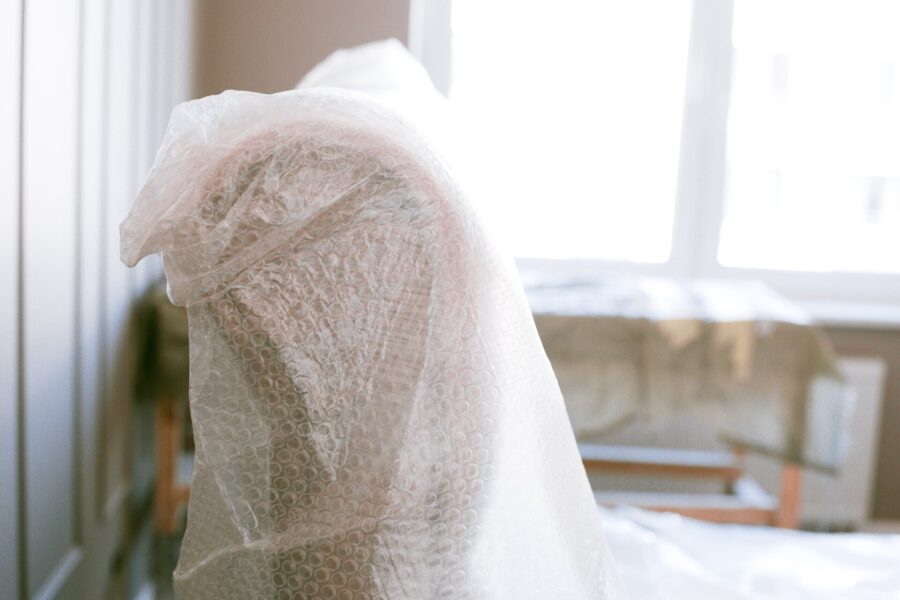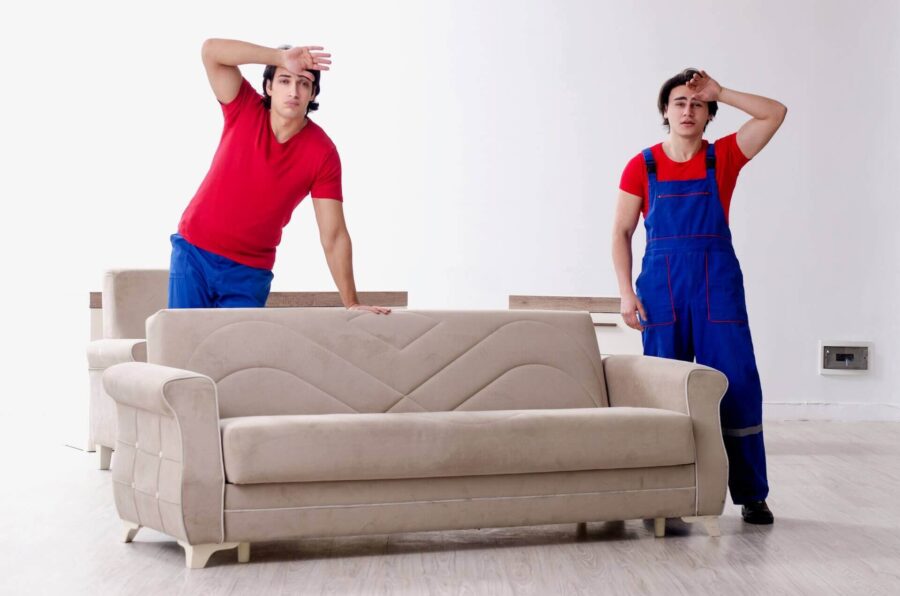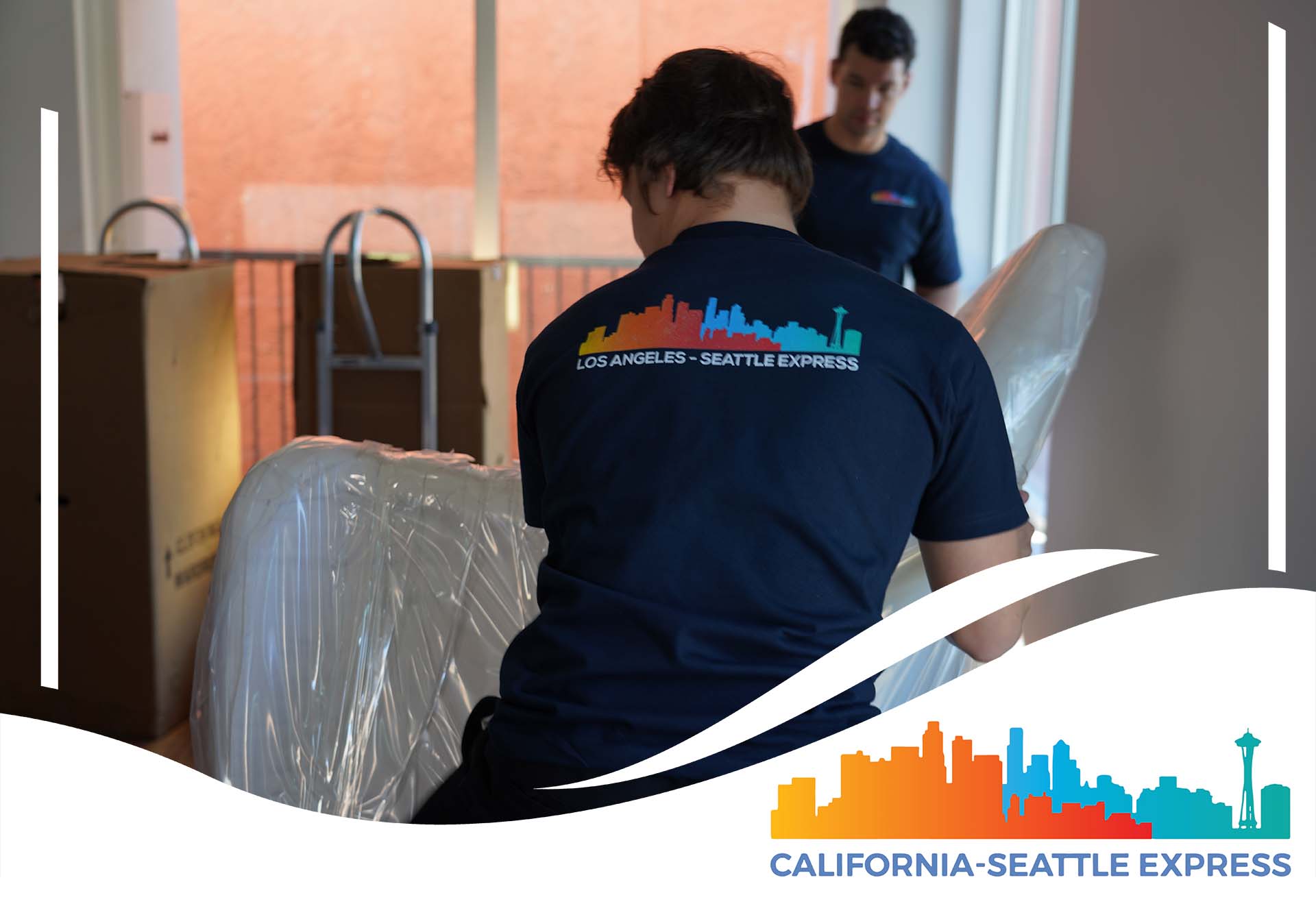When embarking on a move, whether with movers from Seattle to California or anywhere in the US, the mere thought of packing furniture can be daunting. Let us equip you with the skills, tips, and tricks on how to pack furniture for moving with finesse, making relocation as smooth as possible.

To pack furniture for a move, start by disassembling any large pieces that can be taken apart. Clean the furniture thoroughly and protect delicate surfaces with bubble wrap or moving blankets. Use plastic covers or sheets for protection from dust and moisture. Wrap individual items in moving blankets or bubble wrap, paying attention to corners and fragile parts. Securely tape or wrap everything in place. Lastly, label each item and box to easily identify them during unpacking.
The Significance of Packing Furniture for a Move Properly
Learning how to prepare furniture for moving is a critical part of the process, especially if you are relocating cross-country. Correctly packing and moving furniture ensures its safety during transit and reduces the likelihood of damage.
Whether you are relocating to another state alone or with the entire family, understanding the significance of packaging furniture well is essential. That’s something cross-country movers could help with the most, as they know the stakes of shipping furniture across various states.
What you’ll need for a successful relocation is good preparation, appropriate packaging materials and tools, and assessing whether everything has to come along. This last step might be crucial for successfully relocating your home, family, and furnishings.
Assessing and Preparing Furniture
Before you pack, assess and prepare your furniture. This process will help you determine the best way to pack your items and plan how to pack a relocation truck in the right layout. Here are some relocation hacks you might find useful.
Identify Items That Require Special Packing Considerations
One of the first relocation tips you must remember is that not all furniture pieces are created equal. Some may require additional attention or special packaging materials. For instance, antique furniture, items with glass elements, or particularly delicate items need more careful handling. Identifying items by their purpose is a common thing people forget to do when relocating.
Additionally, pay attention to furniture with fragile finishes or upholstery that could be damaged during the move. Knowing which items need extra care will ensure they get packed with appropriate packaging materials and techniques.
Prepare Furniture Surfaces and Remove Detachable Parts
To move efficiently, clean and dry furniture surfaces to prevent mold and mildew. Vacuum upholstered furniture and wipe down wooden or metal surfaces with a damp cloth. Make sure everything is thoroughly dry before packaging.
Also, disassemble large furniture to make it easier to transport. This may include removing legs from tables or sofas, taking apart bed frames, or detaching shelves from bookcases. Disassembling furniture makes it easier to move and helps prevent damage during transit.
If you’re unsure how to disassemble a particular piece of furniture, consult the manufacturer’s instructions or seek guidance from professional movers.
Keep Track of Furniture Pieces for Easier Assembly Later
During the disassembly, it’s a good idea to keep track of all the parts, especially when moving at the last minute. Keep screws, bolts, and other small parts in labeled bags to reassemble the furnishings quickly. Attach the bags to the corresponding furniture using tape or a zip tie.
Take pictures of the disassembled furniture, focusing on the connections and joints. These photos can serve as a visual guide when it’s time to put everything back together. For more complex pieces, consider creating a numbered system to label each part and its corresponding location.
By thoroughly assessing and preparing your furniture, you can ensure a safer and more efficient relocation. This attention to detail will ultimately save you time and effort during packing and unpacking.

Essential Packing Supplies or How to Protect Furniture When Moving
A checklist for moving into a new house should include essential packaging supplies for protecting your furnishings. Using appropriate materials can make a significant difference in the condition of your furniture upon arrival at your new destination. Here’s a closer look at the packaging materials, furniture protectors, and tools.
Packing Materials
Bubble wrap is an essential material. It provides excellent protection for your furniture against scratches and dents. When applying bubble wrap, ensure that the bubbles are facing the item for optimal protection. The air-filled bubbles provide a cushion that absorbs shocks and impacts during transit.
Other packaging materials, like paper and stretch wrap, are also necessary for additional padding and protection. Paper is ideal for wrapping around objects and filling empty spaces in boxes, while stretch wrap can secure blankets or bubble wrap around furniture.
Consider using corrugated cardboard sheets for added protection. These sheets can be placed on flat surfaces, corners, or edges of furniture pieces for extra padding.
Furniture Protectors
When relocating, whether with movers from California to Seattle or the other way around, furniture protectors such as blankets and furniture pads are crucial. They provide a layer of protection against scratches, dings, and other forms of damage, so include them in your relocation day preparation.
Relocation blankets are thick and padded, providing excellent protection for most furniture pieces. They can be draped over furniture and secured with stretch wrap or bands. If you don’t know where to find blankets, make that one of the questions to ask movers.
Furniture pads, often made from felt, can be placed under the legs of furniture to protect floors from scratches when moving items around. They can also be used to pad corners and edges during relocation.
Packaging Tools
Investing in high-quality packaging tools can make the process easier and more efficient. A tape dispenser is a must-have tool that allows for quick and easy application of tape. It is particularly useful when sealing large numbers of boxes.
All types of packing tape are necessary for securing bubble wrap, blankets, and boxes. This type of tape is strong and durable, ensuring it doesn’t break or peel off during the move.
A utility knife is another essential tool. It can be used to cut packaging materials to the right size, open boxes, and remove packaging materials once you’ve reached your destination. Additionally, consider investing in a set of furniture sliders. These tools make it easier to shift heavy furniture across floors without causing damage.
Using the right supplies is not just about protecting furniture during shipping but also about making unpacking more efficient once you reach your new home. If you want to get your packaging supplies for free, the interesting man in the video below explains where to find some.
How to Pack Furniture – Step-By-Step Instructions
Packing furniture for relocation requires careful planning and execution, much like when you plan a move to another city. Learn the process step by step, ensuring your furniture is well-protected during shipping and without needing to call long-distance moving services.
Techniques for Wrapping Furniture for Relocation
To wrap your furniture, first, take away removable elements like cushions, shelves, or drawers. Cover the piece with a blanket or bubble wrap, starting from one end and working your way around the item. Ensure all areas are covered, and remember the corners, which are often the most vulnerable to damage.
Secure the wrap with packing tape, ensuring it’s tight enough to hold everything but not so tight that it puts too much pressure. The goal is to create a protective layer that shields your furniture from bumps, scratches, and other potential damage when it’s time to move.
Securing Loose Parts
Secure any loose parts on furnishings to prevent them from shifting during shipping. This includes drawers, doors, and other parts that could slide or swing open. Use tape or stretch wrap to secure these elements.
For items like screws, bolts, or other small parts, store them in a small labeled bag. Attach it to the corresponding piece of furniture, so it’s easy to find when you’re ready to reassemble.
Proper Box Selection
Choosing the right boxes is critical when relocating. They should be sturdy enough to hold the weight of your items. Reinforce the bottom of heavy boxes with extra tape for added security.
The size of the box is also important. Make sure they’re not too big or small. A box that’s too large can cause items to shift during transport, potentially leading to damage. On the other hand, a box that’s too small might not close properly, leaving everything exposed.
Use smaller boxes for heavier items like books and larger boxes for lighter, bulkier items like bedding or curtains. If you’re packaging a piece of furniture that’s small enough to fit in a box, create enough space for padding materials to protect the item.
Furniture that’s too large to fit in a box should be carefully wrapped and secured to prevent damage. If dealing with an exceptionally large or heavy piece of furniture, you may want to consider hiring professional movers for more skilled handling.

Packing Strategies for Different Types of Furniture
Different types of furniture require different packing strategies, and that’s something you’ll find out when you start preparing to move out for the first time. These strategies vary based on the material and size of items and their unique features.
Here’s a guide on how to handle various furnishings during your move.
Tips for Upholstered Furniture
Upholstered things like sofas, armchairs, and mattresses require special care to avoid damage and dirt during shipping. First, vacuum the upholstery to remove any dust or debris.
Protect it by covering it with relocation blankets. Start from one end and work your way to the other, covering every last bit. Once the item is covered, wrap it in stretch wrap, which will keep the blanket in place and provide an additional protective layer.
For mattresses, consider investing in a mattress bag. They offer excellent protection against dirt, dust, and moisture.
Techniques for Protecting Wooden Furniture
Wooden furnishings can scratch or dent easily, so protecting them during relocation is crucial. Start by taking away any removable elements like shelves or drawers.
Use bubble wrap to protect corners and edges, which are vulnerable to damage. Secure the wrap with tape and cover the entire piece with blankets, securing them with stretch wrap.
For fine wood furniture, consider using furniture pads for extra protection. They’re designed to prevent scratches and other damage to delicate wood surfaces.
Special Considerations for Moving Oversized or Unique Furniture Pieces
Oversized or unique furniture may require special handling or equipment. This includes items like grand pianos, pool tables, armoires, and antiques. These items may need to be disassembled before transport or require special equipment like dollies and lifting straps.
If you’re unsure how to handle these items, it’s best to consult with a professional mover. They have the expertise and equipment to safely pack and ship these items.
There are also certain items movers won’t move due to safety or legal reasons, like some plants, hazardous materials, and perishable foods. Always check with your movers ahead of time if you have concerns or questions about specific items.
Techniques for Loading and Transporting Furniture
Once your furniture is packed, it’s time to load it onto the relocation truck. Here are some tips that even the most experienced long-distance moving company would give someone like you who’s relocating:
- Heaviest items first – Load the heaviest items into the truck first. This will help balance the weight in the truck and prevent lighter items from being crushed.
- Balance the load – Distribute the weight evenly on both sides of the truck.
- Secure your items – Use straps or ropes to secure your items and prevent them from shifting during transit.
- Fill in gaps – Use soft items like bedding or cushions to fill in gaps and provide extra padding.
While it’s always a good idea to host a moving away party to say goodbye to friends and neighbors, don’t forget to also hire professional packing services to make moving smoother and less stressful.
Packing Services
Our professional packers have methods and techniques to ensure all your items are intact during and after the move.
Storage Services
Looking for storage space while you get settled? California-Seattle Express provides 30 days free storage with your move.
Car Shipping Services
We can ship your vehicles using the best freight options available. Your car will be moved safely and securely and arrive as planned.
Don’t Learn How to Pack Furniture for Moving Alone – Call Long-Distance Movers for Help
Learning how to pack furniture is a valuable skill, but it doesn’t mean you have to do it alone. A cross-country moving company like California-Seattle Express can help you handle the task professionally. Hiring movers can save you time and stress, allowing you to focus on settling into your new home.
The benefits of relocating are numerous – from new opportunities and experiences to personal growth. But it can also be challenging. With California-Seattle Express, trusted movers from Seattle to California, you can rest assured that your furnishings will be packed with finesse and moved safely to your new destination.
Ready to move big? Contact us today for a free quote and let our team of experts take the stress out of your relocation.
FAQ
How Should I Prepare My Furniture for a Move?
To prepare your furniture for relocation, you should clean it, remove detachable parts, and protect surfaces with suitable materials. It’s also helpful to measure larger pieces to ensure they’ll fit through doorways and hallways at your new location.
What Are the Best Techniques for Protecting Furniture When Moving?
Protecting furniture involves several techniques. Using bubble wrap, stretch wrap, and relocation blankets can help protect your furniture from scratches, dents, and other damage. Securing loose parts and wrapping sharp corners is also essential.
Are There Specific Materials I Should Use to Wrap Furniture During Packing?
Yes, certain materials are ideal for wrapping furniture during packing. These include bubble wrap for protection, blankets for padding, and stretch wrap to secure the wrapping in place. Using tape to seal bubble wrap and other materials is also necessary.
How Do I Disassemble Furniture Properly for Easier Packing?
To disassemble furniture, start by taking off removable elements like cushions, shelves, or drawers. For more complex pieces, refer to the manufacturer’s instructions or search online for guides. Keep track of all the screws, bolts, and other parts, and store them in a clearly labeled bag.
Can I Use Plastic Wrap or Stretch Film to Protect My Furniture?
Yes, plastic wrap, also known as stretch film or stretch wrap, can be used to protect your furniture. It’s great for securing moving blankets or bubble wrap in place and can also help to keep drawers and doors closed during transit.
Are There Different Packing Strategies for Different Types of Furniture?
Yes, different types of furniture require different packaging strategies. For instance, upholstered furniture should be covered with blankets and then wrapped in stretch wrap, while wooden furniture benefits from the use of bubble wrap on corners and edges before covering it with blankets.
Should I Label the Furniture Pieces and Their Disassembled Parts?
It’s highly recommended to label furniture and its disassembled parts. This will make reassembly much easier at your new home. You can write directly on the tape used to secure bubble wrap or use a separate label.
What Are Some Loading Techniques to Ensure Safe Transport of Furniture?
When loading furniture into the truck, start with the largest and heaviest items. These pieces should be placed toward the back of the truck. Ensure they’re secure and won’t shift during transport. Use moving straps or ropes if necessary.
Are There Any Tips for Unpacking and Reassembling Furniture After a Move?
When unpacking, reverse the order in which you packed. Start with the largest items first, and carefully follow your labeled instructions for reassembly. Take care when removing packing materials to avoid causing damage.
How Can I Arrange Furniture in the New Space for Optimal Functionality and Aesthetics?
Create a floor plan for your new space and decide where each piece of furniture will go. Consider the flow of movement, the room’s purpose, and how furnishings can complement the aesthetic. Don’t be afraid to experiment with different layouts until you find one that feels right.





